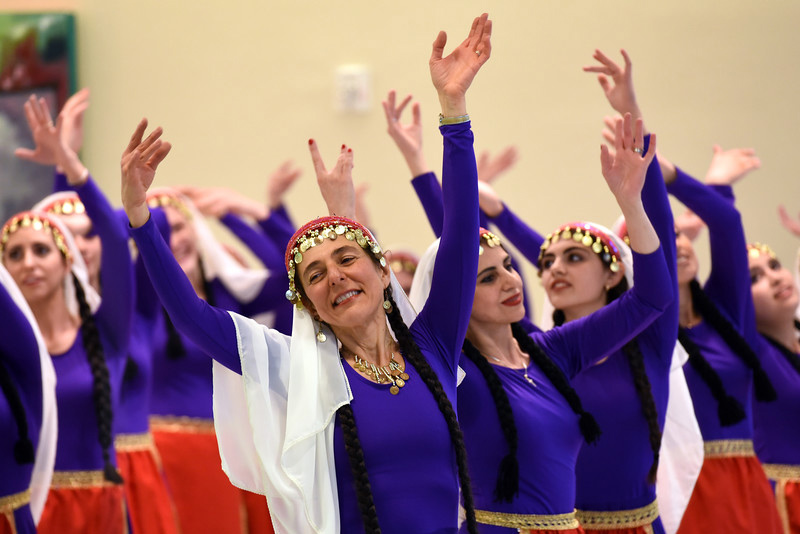Dancing Armenian in Anatolia, the Caucasus, and Beyond

Armenian identity is not about place. And yet, it’s always about place. Through dance we nurture our Armenian identity, connecting communities around the world.
In the Villages
Armenian villages are nestled in and among the Caucasus Mountains and the Anatolian valleys. Since you might have had to climb over a mountain to get to the next village, people tended to stay put, and thus for centuries, each village developed its own variants of dances. The wildness of the landscape—the flora, the fauna—found its way into dance. For instance, the woman solo dancer holds her fingers so that they look like the head of the gazelle (maral, in Armenian). The men’s dance kotchari (listed as Intangible Cultural Heritage by UNESCO in 2017) represents the movements of goats, jumping and leaping.

As early as the twelfth century, villagers traveled to large religious festivals, not only to participate in spiritual activities but also to share dances. According to dance researchers Susan and Gary Lind-Sinanian, they carried these dances home, adapted them to their own styles, and incorporated them into the local repertoire.
Song-dances (bari-yerker) are simple dances, accompanied by call-and-response singing between the dance leader and the other participants. Most of these dances did not survive after 1915, when families and whole communities were lost.
Other village dances (barer) are accompanied by small instrumental ensembles, or by folk orchestras in the cities. Like much Eastern music, Armenian music is modal, based on un-tempered scales instead of octaves. Armenian dance music also features unusual rhythms such as 5/4 and 9/8.
From East to West
There are two distinct styles of dance: Western Armenian (Anatolian) and Eastern Armenian (Caucasian). Anatolian Armenian dances are generally in an open circle with the leader to the right, little fingers interlocked. Historically and even today, some dances are done only by men, some only by women, and some in mixed lines. Traditionally, a few dances styles are for solo, couple, or trio performance. In rural Western Armenia, the couple dances were commonly done by members of the same gender. A man and woman dancing together as a couple is more typical of the urban areas or Eastern Armenia.




In the twentieth century, Armenian folk dance continued to flourish both in Armenia and in diaspora communities around the world, with influence from European, Middle Eastern, and American dance styles. Under the Soviet Union, Russian ballet masters were sent to the Republics to “refine” folk dances for the stage. Caucasian Armenian dances came to reflect the discipline and precision associated with the Russian ballet.
“You’ll Have It All at the Armenian Folk Ball”
The first documented diaspora performing group in the United States was the Armenian Folk Dance Group of Boston (1926–1928). The Armenian Folk Dance Society of New York formed in 1937, initially to represent Armenia at international festivals. The society was the first Armenian group in the United States to attempt to systematically collect the dances from the various provinces. They performed at concert halls and festivals in New York City, including two World’s Fairs, eventually with over twenty-five different regional dance styles in their repertoire.


In the 1940s and 1950s, Armenian Americans created new dances to replace what had been lost by combining traditional and contemporary choreography with older folk songs. Many of these were created and diffused by teens in summer camps and then adopted by adults. One camp group won first prize in a dance competition with the “Raisin Stomp,” taking inspiration from the Tamzara, a traditional dance in 9/8 rhythm with variations in each region of the old country. It quickly spread throughout the United States and now is often the only version you see at Armenian American parties.
In the 1960s, the Armenian State Dance Ensemble from Yerevan toured the United States. Their powerful, ballet-derived folk dances captivated Armenian American audiences. They interpreted them to be “purer” forms of Armenian dance, coming from the Republic, and performance groups began to pattern their repertoires after the ensemble. Armenian American dancers sought training from Soviet Armenian dance masters. This is the style usually performed by most diaspora dance groups today.
Until about the 1980s, “compatriotic unions”—groups of people who had come from villages or towns in Turkey—gathered at picnics to preserve Anatolian Armenian folkdances, among other aspects of cultural identity. Together they retained the dances of each region and shared with other Armenian Americans from other regions.

Today, Armenian churches in the United States often host festivals, selling Armenian food and hosting live music. Many of us will spontaneously jump up from our meal to dance between the picnic tables when the band plays a favorite tune.
The invention of YouTube has been an extraordinary artistic and research tool for dancers, especially considering our history of loss and dispersion to countries that were closed to each other. By sharing repertoire and regional styles, Armenian dance groups around the world have perhaps even created a “Pan-Armenian” dance style. As a living tradition, Armenian dance continues to evolve and adopt contemporary forms.
The Armenia: Creating Home program at the 2018 Smithsonian Folklife Festival in Washington, D.C., will be the first U.S. event to bring together dance groups from Armenia, the United States, and beyond. Will the Festival spark a new creative chapter in Armenian folkdance heritage? My guess is, yes! Come check it out and join the dance circle.
Next week on the Festival Blog: “One, Two, Three; Step, Swing” Armenian Dance Across Generations
Carolyn Rapkievian is serving as an Armenian dance advisor for the 2018 Folklife Festival and is assistant director for interpretation and education at the Smithsonian’s National Museum of the American Indian.

